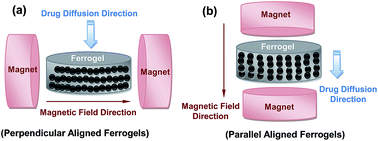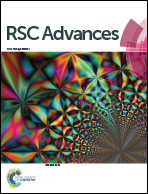Influence of magnetic nanoparticle arrangement in ferrogels for tunable biomolecule diffusion
Abstract
Magnetic sensitive hydrogels (ferrogels) with tunable nanochannels were prepared with poly (vinyl alcohol) (PVA) and iron oxide magnetic nanoparticles under a uniform magnetic field in a freezing–thawing process, evaluated by differential scanning calorimetry (DSC), and the influence of magnetic nanoparticle arrangement on the diffusion behavior of biomolecules was investigated. Nanochannels self-assembled by the arranged magnetic nanoparticles could be tuned by manipulating the direction of the magnetic field, which results in the formation of “needle-like” structures from the magnetic nanoparticles aligned parallel or perpendicular to the permeation direction (anisotropic ferrogels). The effect of biomolecule diffusion between the anisotropic and isotropic ferrogels was observed in a diffusion diaphragm cell (using random nanoparticle dispersions without a magnetic field, as a control). It was established that the parallel-aligned ferrogels exhibit a higher drug diffusion rate compared to the isotropic ferrogels, whereas the perpendicular-aligned ferrogels display the lowest biomolecule diffusion rate. The novel ferrogels were expected to be suitable for application in bio-membranes, and the nanochannels for biomolecule (MW: ca. 0.1–10 kDa) diffusion could be constructed precisely by the magnetic nanoparticle arrangement.


 Please wait while we load your content...
Please wait while we load your content...